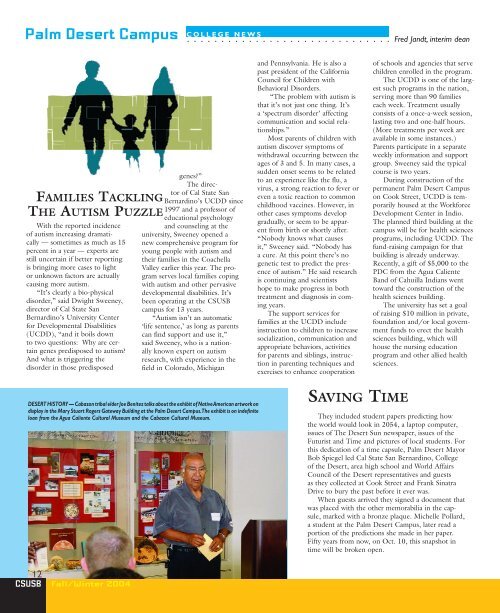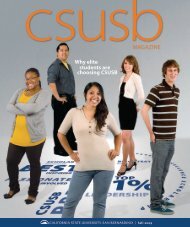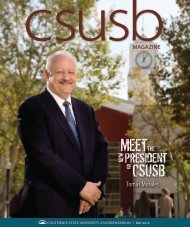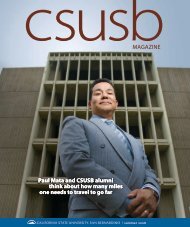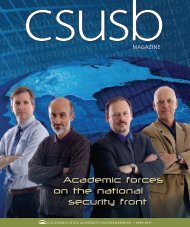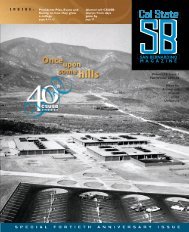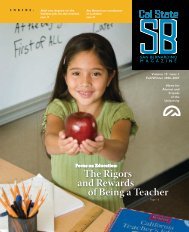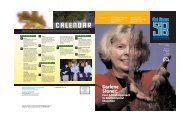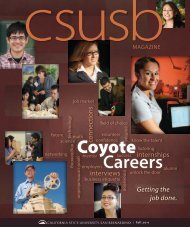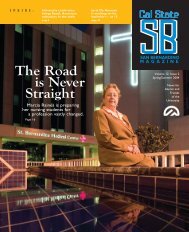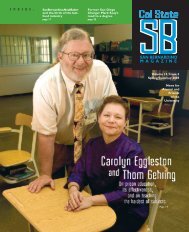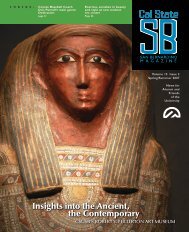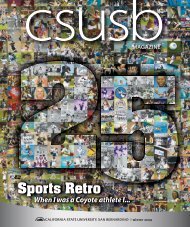Palm Desert Campus C O L L E G E N E W S. . . . . . . . . . . . . . . . . . . . . . . . . . . . . . Fred Jandt, interim deanFAMILIES TACKLINGTHE AUTISM PUZZLEWith the reported incidenceof autism increasing dramatically— sometimes as much as 15percent in a year — experts arestill uncertain if better reportingis bringing more cases to lightor unknown factors are actuallycausing more autism.“It’s clearly a bio-physicaldisorder,” said Dwight Sweeney,director of Cal <strong>State</strong> <strong>San</strong>Bernardino’s <strong>University</strong> Centerfor Developmental Disabilities(UCDD), “and it boils downto two questions: Why are certaingenes predisposed to autism?And what is triggering thedisorder in those predisposedgenes?”The directorof Cal <strong>State</strong> <strong>San</strong>Bernardino’s UCDD since1997 and a professor ofeducational psychologyand counseling at theuniversity, Sweeney opened anew comprehensive program foryoung people with autism andtheir families in the CoachellaValley earlier this year. The programserves local families copingwith autism and other pervasivedevelopmental disabilities. It’sbeen operating at the <strong>CSUSB</strong>campus for 13 years.“Autism isn’t an automatic‘life sentence,’ as long as parentscan find support and use it,”said Sweeney, who is a nationallyknown expert on autismresearch, with experience in thefield in Colorado, Michiganand Pennsylvania. He is also apast president of the <strong>California</strong>Council for Children withBehavioral Disorders.“The problem with autism isthat it’s not just one thing. It’sa ‘spectrum disorder’ affectingcommunication and social relationships.”Most parents of children withautism discover symptoms ofwithdrawal occurring between theages of 3 and 5. In many cases, asudden onset seems to be relatedto an experience like the flu, avirus, a strong reaction to fever oreven a toxic reaction to commonchildhood vaccines. However, inother cases symptoms developgradually, or seem to be apparentfrom birth or shortly after.“Nobody knows what causesit,” Sweeney said. “Nobody hasa cure. At this point there’s nogenetic test to predict the presenceof autism.” He said researchis continuing and scientistshope to make progress in bothtreatment and diagnosis in comingyears.The support services forfamilies at the UCDD includeinstruction to children to increasesocialization, communication andappropriate behaviors, activitiesfor parents and siblings, instructionin parenting techniques andexercises to enhance cooperationof schools and agencies that servechildren enrolled in the program.The UCDD is one of the largestsuch programs in the nation,serving more than 90 familieseach week. Treatment usuallyconsists of a once-a-week session,lasting two and one-half hours.(More treatments per week areavailable in some instances.)Parents participate in a separateweekly information and supportgroup. Sweeney said the typicalcourse is two years.During construction of thepermanent Palm Desert Campuson Cook Street, UCDD is temporarilyhoused at the WorkforceDevelopment Center in Indio.The planned third building at thecampus will be for health sciencesprograms, including UCDD. Thefund-raising campaign for thatbuilding is already underway.Recently, a gift of $5,000 to thePDC from the Agua CalienteBand of Cahuilla Indians wenttoward the construction of thehealth sciences building.The university has set a goalof raising $10 million in private,foundation and/or local governmentfunds to erect the healthsciences building, which willhouse the nursing educationprogram and other allied healthsciences.DESERT HISTORY — Cabazon tribal elder Joe Benitez talks about the exhibit of Native American artwork ondisplay in the Mary Stuart Rogers Gateway Building at the Palm Desert Campus. The exhibit is on indefiniteloan from the Agua Caliente Cultural Museum and the Cabazon Cultural Museum.SAVING TIMEThey included student papers predicting howthe world would look in 2054, a laptop computer,issues of The Desert Sun newspaper, issues of theFuturist and Time and pictures of local students. Forthis dedication of a time capsule, Palm Desert MayorBob Spiegel led Cal <strong>State</strong> <strong>San</strong> Bernardino, Collegeof the Desert, area high school and World AffairsCouncil of the Desert representatives and guestsas they collected at Cook Street and Frank SinatraDrive to bury the past before it ever was.When guests arrived they signed a document thatwas placed with the other memorabilia in the capsule,marked with a bronze plaque. Michelle Pollard,a student at the Palm Desert Campus, later read aportion of the predictions she made in her paper.Fifty years from now, on Oct. 10, this snapshot intime will be broken open.12<strong>CSUSB</strong>Fall/Winter 20<strong>04</strong>
C O L L E G E N E W SC O L L E G E N E W SSusan Summers, interim dean . . . . . . . . . . . . . . . . . . . . . . . . . . .Extended LearningA NEW LOOK, A NEW PROMISEBusy working adults in the Inland Empirehave spoken. In a survey conducted for theCollege of Extended Learning (CEL) last year,a significant percentage of the groups surveyed— current students, prospective students (peoplealready on mail lists) and people who havemoved to new residences in the Inland Empire— said they were now accustomed to takingcare of personal business on-line.With the help of the Claremont firm ofWilkin-Guge Marketing, current students andthose unfamiliar with CEL were surveyed ontheir awareness of the college and its services,opinions about the college’s image and reputation,as well as attitudes about the value ofcontinuing education.The survey showed that these students andprospective students expect online service evenfrom non-profit organizations, such as educationalinstitutions. The students are also lookingfor better access to educational programs,whether they’re coming by automobile or byInternet.The cumulative impact of these responseswas inescapable, said Susan Summers, interimdean for CEL. “The College of ExtendedLearning had to move forward in becomingeven more convenient, customer-centered andaccessible for our students. It’s clear that theyput a high priority on convenience, service andquality education programs that meet theirparticular professional advancement needs.”There’s no big surprise here, she added.Everyone values convenience and quality. Sowhat difference does the data make? In CEL’scase, Summers said, it will make a big difference.Beginning in October 20<strong>04</strong>, CEL studentscan browse the college’s certificate and courseofferings on its Web site (http://cel.csusb.edu), and also registerat the same site. Theycan even purchasecampus parking permitson-line, savingtime and energy whenarriving for classes.The college is alsoimproving access toits extension offeringsby adding many moreon-line courses, andsoon it will add staffingat the Palm DesertCampus to increasecontinuing educationservice to theCoachella Valley.In addition, a varietyof discounts areavailable for membersof certain professionalassociations,as well as for educatorswho register forCEL bulletin of courses covermultiple courses in the same quarter. Popularprograms, such as the certificates in humanresources, grant development and management,Web page design and logistics managementand desert studies courses, are the samethis year. But the computer-aided draftingcertificate and the management and leadershippractices certificates have been updated withnew materials and software.With all the changes, Summers and herstaff have also given the college a new look.She believes it conveysthe messageof convenience andquality that’s “withinreach” for area residentsand even thoseabroad.CEL has alreadyused that look on itsbulletin of coursescover and in newspaperads. The cleanand simple style highlightsthe Web site aswell as faces of students.And the newlook includes a newlogo, which was chosenby several sampleconstituent groups.It combines theuniversity’s logo witha fresh use of color,and incorporatesCEL’s “within reach”tag line. The college’s look, Summers said,now emphasizes its promise of convenience,service, quality, access and affordability.INSIDE THE HALLS OF POWEROne of the nation’s oldest and most prestigious legislative fellowshipprograms has selected Qiana Charles, former program administratorin the College of Extended Learning, for the 20<strong>04</strong>-2005 Jesse MarvinUnruh <strong>California</strong> Assembly Program.Qiana was chosen as one of 18 participants from a field of 300 applicants,which went through a rigorous two-stage selection process. The11-month program provides an introduction to public policy formationand adoption in the <strong>California</strong> Legislature through full-time work asa professional legislative staff member. Qiana wanted to enter the fellowshipprogram to learn how laws are created, written and eventuallypassed. When she’s done, she hopes to have a better understanding oflocal governance and how it impacts the community.Qiana’s areas of interest include higher education, jobs, economicdevelopment, cyber crime, bridging the achievement gap and urbanyouth. She looks forward to utilizing the fellowship program as a stepping-stonetoward attending law school and becoming a communityactivist. She is an alumna of <strong>CSUSB</strong>, graduating from the universityin 1998 with a B.A. in communication, and then going on to Howard<strong>University</strong>, where she earned an M.A. in organizational communicationin 2000. Says Qiana, “As a proud product of all things wonderful in <strong>San</strong>Bernardino, I could not think of a better way to give back to the community.”If this were not enough, the League of Women Voters in <strong>San</strong>Bernardino honored Qiana as a 20<strong>04</strong> Citizen of Achievement. She wasrecognized for performing more volunteer service in her young adultlife than many people do in a lifetime. Beginning with her volunteerismwith the Black Future Leaders, Inc., she ascended to a board of directorsposition, and is responsible for outreach and enrollment. In addition,she has volunteered her time and technology skills in the assistance ofthe national Council of Negro Women and to the Kappa Alpha Sorority.Qiana left her post as an administrator in the College of ExtendedLearning this fall to take up her new duties as an Unruh Fellow inSacramento.Fall/Winter 20<strong>04</strong>13<strong>CSUSB</strong>


